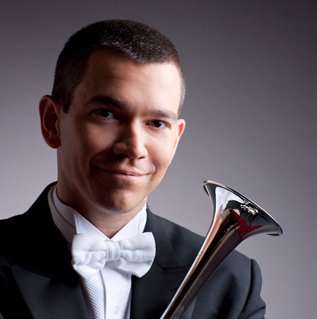|
Back
The Hungary Games New York
David Geffen Hall, Lincoln Center
10/06/2016 - & October 7, 8, 2016
György Ligeti: Mysteries of the Macabre
Ludwig van Beethoven: Piano Concerto No. 4 in G major, Opus 58
Béla Bartók: Music for Strings, Percussion and Celesta, sz. 106, BB114
Christopher Martin (Trumpet), Lang Lang (Piano)
New York Philharmonic Orchestra, Alan Gilbert (Conductor)

C. Martin (© Todd Rosenberg)
Alan Gilbert’s performance of the complete Le Grande Macabre some years ago showed such a deft handling of Ligeti’s arcane masterpiece, that one was ready to accept the nine-minute version of three arias, set for trumpet (or soprano) as the highlight of this week’s concert. Little did I realize that Mr. Gilbert had an even more astonishing handle on Ligeti’s Hungarian companion, Béla Bartók.
That, though, was the second half of this most colorful concert. And pairing the two in one concert was a stroke of creative inspiration.
Yet the real soloist star of the evening was the Phil’s First Chair trumpet, Christopher Martin, who made an appropriately merry show of the Mysteries of the Macabre. In the complete opera, so many lunatic actions take place that one might not spot the “arias.” But they are present. In the original version of this several years ago, three of them were arranged for soprano and orchestra–and the soprano became sick!
What to do? With Ligeti, anything is possible, so the conductor, a trumpeter himself, enlisted the great Hĺkan Hardeberger to take over. The composer liked the “substitution” so much that this has become a staple for trumpeters everywhere.
And no wonder! This is a “play-piece”, with both Alan Gilbert and Mr. Martin acting out the music. The conductor with a faux-annoyance that the trumpeter wasn’t on stage, Mr. Martin running on stage breathlessly, the conductor conducting to silence, the trumpeter coming on with lunatic riffs, lunatic words, Mr. Gilbert questioning “What did you say?”, and the entire chamber ensemble of the Phil continuing with nonsensical sonorities. The highest trumpet note, the lowest tuba, an inappropriate stringendo from the strings, and more marvelous trumpet playing by Mr. Martin...
It was a nine-minute circus. Ergo, that incessant games-inventor, games-player György Ligeti would have heard it like he heard his opera: as “a colorful comic strip.” And a lovely beginning.
Which brings us to the other Hungarian, Béla Bartók. And Alan Gilbert’s positively riveting conducting of the Music for Strings, Percussion and Celesta.
It was not riveting for being especially fiery or even particularly Hungarian. But Mr. Gilbert’s conducting of that opening crescendo, fractionally creeping up the scale, was a virtual lesson in discipline. The strings of the Phil, the conductor’s quantum-movements, leading to a dazzling climax.
More was on the way, with a rippling scherzo. I had heard it with more sensational snap-pizzicati, but rarely with such impeccable playing. The third movement was simply other-worldly, as it should be. The diaphanous strings, the glistening celesta, and the always wonderful playing of Eric Huebner led to something on the cusp between the eerie and the sensual.
Most essential of all was how Mr. Gilbert eschewed Hungarian “effects” for a perfect equation, which itself has its own beauty.
Granted, the other Hungarian here, Mr. Ligeti, can be equally effective, but where he delights in the numbers and the sensations, Béla Bartók achieves the substratum of music, catching the Pythagorean numbers beneath the strings.
And Mr. Gilbert, with the polish of the Phil, portrayed that ineffable image.

L. Lang (© NY Philharmonic)
And now we come to the problem of Lang Lang. Actually, this initial problem–the flashy technique (which really is amazing), the hands-to-the-heart, the face lifting to heaven–isn’t terrible in itself. One imagines Franz Liszt to perform the same way.
But this isn’t the mid-19th Century, and one expects Beethoven to be more controlled. Catching more than those wonderful notes, giving greater contrasts, more depth.
That, though, might be asking too much. First, one does have to marvel at Lang Lang’s (Mr. Lang’s?) finger work. The long first movement cadenza was taken at more than speed. Those keys came as close to glissandi as possible, the transition to the original theme on top of the pyrotechnics was brilliant. Ditto for the final movement.
Was it my own vision of the early Lang Lang, that I found his efficiency to be soulless? Yes, it could be a shortcoming. When Yuja Wang shows her fashionista color, it enhances, or complements the music. With Lang Lang, the fingers are extraordinary, but one feels that this can be the be-all and the end-all.
His coordination with Mr. Gilbert seemed fine. Yet when the conductor started the Andante with volcanic tones, he perhaps was looking for Lang Lang to follow with the softest contrast. That didn’t quite work out. I remember a particularly tedious Pictures at an Exhibition, when Lang Lang played beautifully, but we missed the pictures themselves. Last night, he played emphatically, quite beautifully, but one had the feeling he was showing far far more of Lang Lang than the underlying, still cryptic inspiration of Ludwig Van himself.
It was still a lively performance, and Lang Lang still astounds an audience which comes to hear, instead of profound music, absolutely fabulous piano-playing.
Harry Rolnick
|